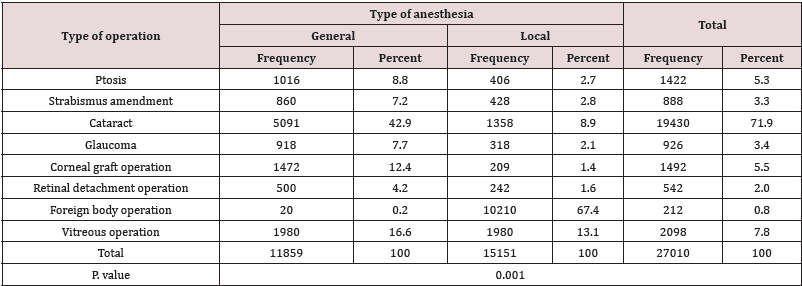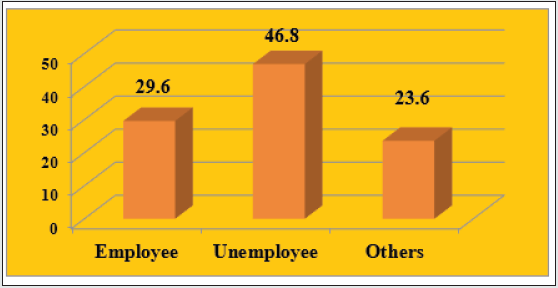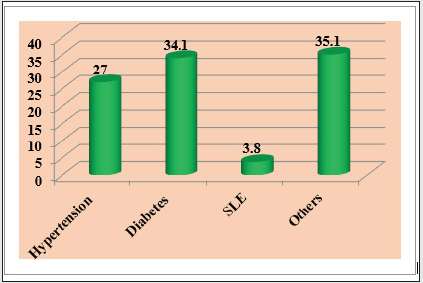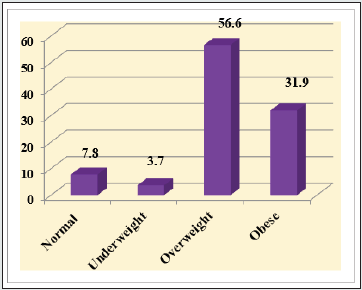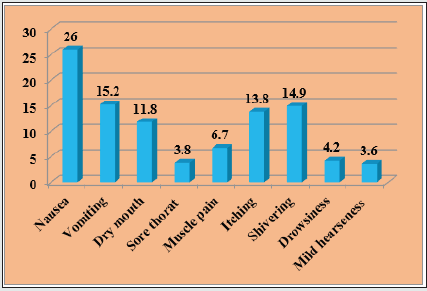
Lupine Publishers Group
Lupine Publishers
Menu
ISSN: 2641-1725
Research Article(ISSN: 2641-1725) 
Comparison of General or Local Anesthesia Among Patients of Ophthalmic Surgery in Baghdad-Iraq Volume 6 - Issue 1
Saad Kadhom Hamid Al Zawi*
- High Diploma of Anesthesia, Iraqi Ministry of Health, Iraq
Received: January 08, 2022 Published: February 4, 2022
*Corresponding author: Saad Kadhom Hamid Al-Zawi, High Diploma of Anesthesia, Iraqi Ministry of Health, Iraq
DOI: 10.32474/LOJMS.2022.06.000232
Abstract
Understanding the effects of anesthesia and the techniques used in eye surgery are very important to providing perioperative anesthesia care. This study aimed to identify the type of anesthesia was used of ophthalmic surgery and comparison between them during the study period. A cross-sectional study was conducted in all the hospital which included the eyes clinic in Baghdad. All the cases admitted from the 1st of January 2020 up to the end of December 2020 were enrolled in this study. We included all the cases of various reasons. Semi-structured questionnaire was used to collect the information on them. The sample size was 27,010 cases. Data was described by using the descriptive statistics such as frequency, percentage, Fisher chi-square, and p. value. STATA version 14 statistical package was used to analyze the data. There was 37.9% of them were in the age groups 51 to 65 years old; female cases 60.5% were more than 39.5% male cases; 46.8% were unemployed; 71.9% of the studied sample had cataract operation; followed by 7.8% had vitreous and 5.3% had ptosis operation. There was a significant association has been found between the type of operation and type of anesthesia at the p.value =0.001. Half of them were used local anesthesia during the eyes operation. Nausea and vomiting are the main side effect of anesthesia. We need effective communication and planning among all involved and it’s essential to safe and efficient perioperative care.
Keywords: Anesthesia; Local; General; Eyes Operation; Comparison
Introduction
Understanding the effects of anesthesia and the techniques used in eye surgery are very important to providing perioperative anesthesia care [1]. The goals of anesthesia during elective eye surgery should focus on patient safety, providing analgesics for a pain-free experience, and creating optimal surgical conditions to facilitate the procedure in collaboration with surgical staff, including eye surgeons and surgical technicians [2]. It is critical to minimize the risks that may arise during eye surgery under sedation and anesthesia while anticipating and managing any potential outcomes associated with eye surgeries [3]. The most common eye surgeries performed today are cataracts, glaucoma, and vitreoretinal surgery [4]. It is estimated that approximately 26 million Americans suffer from cataracts, and approximately 3.6 million cataract operations are performed annually, making it the most common surgical procedure in the United States [5]. Eye operations are generally considered rather quick operations and do not require general anesthesia, as many operations are performed under local anesthesia using anesthetic drop or through an anesthetic needle for the eye only [6]. Sometimes we may resort to performing operations under general anesthesia [7]. The methods that are followed in anesthetizing the patient during different eye operations may differ based on the type of operation itself, but most types of operations that are performed on the eye are usually done through the use of local anesthesia in the eye in different ways [8-9]. One of these methods is the use of types of drug solutions in the form of drops that are used to numb the sensation in the eye locally [10]. The other method depends on the use of anesthetic solution in the form of needles to be injected into the inner chamber of the eye until it gives the effect of anesthesia in the eye [11]. Local anesthesia is usually safe, and it certainly carries fewer risks than those associated with general anesthesia, but it may sometimes lead to a feeling of darkening in the eyes, a headache, vomiting, muscle twitching, in addition to a persistent feeling of numbness and tingling in the area where it was applied, and its lead to bruising, and bluish skin [12-14]. This study aimed to identify the type of anesthesia was used for ophthalmic surgery and comparison between them during the study period.
Methodology
A cross-sectional study was conducted in all the hospital which included the eyes clinic in Baghdad. All the cases admitted from the 1st of January 2020 up to the end of December 2020 were enrolled in this study. We included all the cases of various reasons. Semi-structured questionnaire was used to collect the information from them. The sample size was 27010 cases. Ethical clearance was obtained from the Ministry of Health/Iraq. Oral and written informed consent was obtained from them before starting to collect our data. Data was described by using the descriptive statistics such as frequency, percentage, Fisher chi-square, and p. value. STATA version 14 statistical package was used to analyze the data.
Results
Out of 27010 studied samples of ophthalmic surgery, there was 37.9% of them were in the age groups 51 to 65 years old; followed by 20.3% in the age 36 to 50 years old and the less frequency 12.1% were in the age groups 21 to 35 years old (Table 1). In Table 2 shows that the female cases 60.5% were more than 39.5% male cases. The highest percentage of studied sample 46.8% were unemployed and 29.6% were employed (Figure1). Most 71.9% of the studied sample had cataract operation; followed by 7.8% had vitreous and 5.3% had ptosis operation (Table 3). The highest percentage 34.1% of them had diabetes disease and 27% had hypertension disease (Figure 2). More than half of the cases 56.6% had overweight and 31.9% was obese (Figure 3). The highest frequency of them 56.1% had local anesthesia and 43.9% had general anesthesia (Table 4). There was a significant association has been found between the type of operation and type of anesthesia at the p. value =0.001 (Table 5). The highest percentage of nausea was 26% and it was the main side effect of anesthesia, followed by vomiting 15.2% and shivering 14.9% 9 (Figure 4).
Discussion
Aging involves a progressive loss of functional reserve in all
organ systems, to the variable extend. Compensation for agerelated
changes is usually adequate, but limitation of physiological
reserve is evident during times of stress such as the perioperative
period [15]. In this study we found that 37.9% of them were in the
age groups 51 to 65 years old; followed by 20.3% in the age 36 to
50 years old and the less frequency 12.1% were in the age groups
21 to 35 years old. Compared with a result done it by Raczynska
in 2016, they mentioned the most of them were elderly people
[16]. In our study, we found the female cases 60.5% were more
than 39.5% male cases. The study was done it by Mitchell in 2013
reported the general anaesthesia patients was more anxious than
local anaesthesia patients and females more anxious than males.
The results indicate that general anaesthesia patients may require
more preoperative information, and gender differences associated
with waiting may need to be given greater consideration [17]. Most
of the studied sample 71.9% had cataract operation; followed by
7.8% had vitreous and 5.3% had ptosis operation. A survey done
in Singapore in 2004 showed 92% cataract extraction was done by
phacoemulsification technique; the anesthetic technique of choice
was peribulbar anesthesia (43%). A survey of members of the
American Society of Cataract and Refractive Surgeons (ASCRS) in
2000 revealed an increase in the use of topical anesthesia among
surgeons. In Oman, over the last few years, anesthesia for cataract
surgery has shifted from general to local anesthesia [18]. In Jordan,
phacoemulsification is the preferred surgical technique for the
cataract. Topical with intracameral anesthesia is the most common
anesthesia for phacoemulsification while retrobulbar anesthesia is
the most common for extracapsular cataract extraction [19].
In addition, the highest percentage 34.1% of them had
diabetes disease and 27% had hypertension disease. In 2017,
Cornelius mentioned to a significant percentage of the patients that
presented for surgery and anesthesia in the ambulatory setting have
type 2 diabetes. It is paramount that all anesthesia providers have
a firm grasp on the concepts associated with the pathophysiology
of type 2 diabetes and associated disease states that frequently
accompany the diabetic patient. It is also of utmost importance
that anesthesia providers understand the pharmacokinetics
and pharmacodynamics of the many types of oral and injectable
antidiabetic drugs that patients with the disease often utilize.
Regimens of the various time-sensitive insulin therapies must
also be understood. This second installment of this 2-part series
on the anesthetic management of type 2 diabetes has addressed
the pharmacology of the various medications used to treat the
disorder and has reviewed the most recent guidelines on blood
glucose management in ambulatory surgical patients [20]. In this
study, more than half of the cases 56.6% had overweight and 31.9%
had obese BMI. Obesity raises the risk of surgical and anesthetic
complications. Otherwise, the obese individuals thus far worse than
normal weight individuals in surgeries [21,22]. Topical and injective
anesthesia (with or without conscious sedation) are generally
methods of choice, but general anesthesia can be preferable or
mandatory in patients with particular internal diseases, children,
emergencies and for extended surgical procedures. Pre-emptive
analgesia before the operation is a meaningful complement of
ophthalmological anesthesia [23].
Skillful anesthetic management is integral to optimal outcomes
after ophthalmic surgery. Although the majority of ophthalmic
operations in the United States are performed with local anesthetic
techniques, nonetheless general anesthesia may be either
necessary or advisable in several challenging circumstances.
Ophthalmic patients are often at the extremes of age and don’t
uncommonly have extensive associated systemic or metabolic
diseases. Because the complications from ophthalmic anesthesia
can be vision threatening or life threatening, it is imperative that the
ophthalmologist and the anesthesiologist understand the complex
and dynamic interaction among patient diseases, anesthetic agents,
ophthalmic drugs, and surgical manipulation [24]. In this study
we found the significant association with the type of operation
and type of anesthesia at the p. value = 0.001. In our study we
found the highest percentage of nausea was 26% and it was the
main side effect of anesthesia, followed by vomiting 15.2% and
shivering 14.9%. Ocular complications associated with anesthesia
in ocular and non-ocular surgeries are rare adverse events which
may present with clinical presentations vacillating between
easily treatable corneal abrasions to more serious complication
such as irreversible bilateral vision loss [25]. Anesthesiologists
as perioperative physicians play a key role in fast-track surgery
through their choice of preoperative medication, anesthetics and
techniques, use of prophylactic drugs to minimize side effects (e.g.,
pain, nausea and vomiting, dizziness), as well as the administration
of adjunctive drugs to maintain major organ system function during
and after surgery [26].
Conclusion
We concluded that most of them were in the age groups 51 to 65 years old; female cases were more than male cases; unemployed; had diabetes history; overweight and obese. Majority of them had cataract operation. Half of them were used the local anesthesia during the eye’s operation. Nausea and vomiting are the main side effect of anesthesia. There was significant association has been found between the type of operation and type of anesthesia.
Recommendation
We recommended to effective communication and planning among all involved and its essential to safe and efficient perioperative care.
References
- Waldschmidt B, Gordon N (2019) Anesthesia for pediatric ophthalmologic surgery. Journal of American Association for Pediatric Ophthalmology and Strabismus 23(3): 127-131.
- Malik A, Fletcher EC, Chong V, Dasan J (2010) Local anesthesia for cataract surgery. Journal of Cataract & Refractive Surgery 36(1): 133-152.
- Walter C (2018) Anesthesia for Ophthalmological Procedures. In Anesthesiology pp. 363-368.
- Berry S, Ligda KO (2015) Ophthalmic surgery. In Basic Clinical Anesthesia pp. 483-487.
- Kelly DJ, Farrell SM (2018) Physiology and Role of Intraocular Pressure in Contemporary Anesthesia. Anesth Analg 126(5): 1551-1562.
- Hug CC (2006) MAC should stand for maximum anesthesia caution, not minimal anesthesia care. Anesthesiology 104: 221-223.
- Tan CSH, Kumar CM, Fanning GL, Lai YC, Au Eong KG (2006) A survey on the knowledge and attitudes of anesthesia providers in the United States of America, United Kingdom and Singapore on visual experiences during cataract surgery. Eur J Anaesthesiol 23: 276-281.
- Gayer S, Zuleta J (2008) Perioperative management of the elderly undergoing eye surgery. Clin Geriatr Med 24(4): 687-700.
- Bayes J (2006) A survey of ophthalmic anesthetists on managing pacemakers and implanted cardiac defibrillators. Anesthesia 103: 1615-1616.
- Local anaesthesia for ophthalmic surgery: Joint guidelines from the Royal College of Anaesthetists and the Royal College of Ophthalmologists. RCoA, 2012
- Aitkenhead AR, Moppett I, Thompson J Smith & Aitkenhead’s (2013) Textbook of Anaesthesia.(6th ed). Elsevier 601–619.
- Royal College of Anaesthetists (2021) Chapter 2: Guidelines for the Provision of Anaesthesia Services for the Perioperative Care of Elective and Urgent Care Patients. RCoA.
- (2020) Local anaesthesia for your eye operation. Patient information leaflet. RCoA.
- Butterworth JF, Mackey DC, Wasnick JD. (2013) Morgan & Mikhail’s Clinical Anesthesiology.(5th ed). McGraw-Hill Education pp. 759-771.
- Kanonidou Z, Karystianou G (2007) Anesthesia for the elderly. Hippokratia 11(4): 175-177.
- Raczyńska D, Glasner L, Serkies-Minuth E, Wujtewicz MA, Mitrosz K (2016) Eye surgery in the elderly. Clin Interv Aging 11: 407-414.
- Mitchell M (2013) Anaesthesia type, gender and anxiety. Journal of perioperative practice. 23(3): 41-47.
- Shah R (2010) Anesthesia for cataract surgery: Recent trends. Oman J Ophthalmol 3(3): 107-108.
- Al-dolat W, Alqudah NM, Atoum D, Al-Omari R, Khatatbeh M (2021) Preferred Surgical and Anesthesia Techniques for Cataract Surgery in Jordan. Clin Ophthalmol 15: 4259-4267.
- Cornelius BW (2017) Patients With Type 2 Diabetes: Anesthetic Management in the Ambulatory Setting: Part 2: Pharmacology and Guidelines for Perioperative Management. Anesth Prog 64(1): 39-44.
- Mandal Ananya. (2019) Obesity and Anesthesia. News-Medical.
- Sabeena S and Rachel P (2018) Pre- operative, assessment risk if you have high body mass index oxford university Hospital NHS Trust. Oxford, USA.
- Schönfeld CL, Reith M (2013) Methods of anesthesia in eye surgery. The Ophthalmologist: Journal of the German Ophthalmological Society 110(2): 175-178.
- McGoldrick KE, Foldes PJ (2006) General anesthesia for ophthalmic surgery. Ophthalmology Clinics of North America 19(2): 179-191.
- Singh RB, Khera T, Ly V, Saini C, Cho W, et al. (2021) Ocular complications of perioperative anesthesia: a review. Graefe's Archive for Clinical and Experimental Ophthalmology 24: 1-5.
- White PF, Kehlet H, Neal JM, Schricker T, Carr DB, et al. (2007) The role of the anesthesiologist in fast-track surgery: from multimodal analgesia to perioperative medical care. Anesth Analg 104(6): 1380-1396.

Top Editors
-

Mark E Smith
Bio chemistry
University of Texas Medical Branch, USA -

Lawrence A Presley
Department of Criminal Justice
Liberty University, USA -

Thomas W Miller
Department of Psychiatry
University of Kentucky, USA -

Gjumrakch Aliev
Department of Medicine
Gally International Biomedical Research & Consulting LLC, USA -

Christopher Bryant
Department of Urbanisation and Agricultural
Montreal university, USA -

Robert William Frare
Oral & Maxillofacial Pathology
New York University, USA -

Rudolph Modesto Navari
Gastroenterology and Hepatology
University of Alabama, UK -

Andrew Hague
Department of Medicine
Universities of Bradford, UK -

George Gregory Buttigieg
Maltese College of Obstetrics and Gynaecology, Europe -

Chen-Hsiung Yeh
Oncology
Circulogene Theranostics, England -
.png)
Emilio Bucio-Carrillo
Radiation Chemistry
National University of Mexico, USA -
.jpg)
Casey J Grenier
Analytical Chemistry
Wentworth Institute of Technology, USA -
Hany Atalah
Minimally Invasive Surgery
Mercer University school of Medicine, USA -

Abu-Hussein Muhamad
Pediatric Dentistry
University of Athens , Greece

The annual scholar awards from Lupine Publishers honor a selected number Read More...








